Advanced Financial Accounting: Analysis of AASB Standards
VerifiedAdded on 2023/03/31
|13
|2597
|266
Report
AI Summary
This report provides a detailed analysis of various theoretical models of accounting, issues related to AASB accounting standards, and the theoretical constructs of contemporary financial accounting. It evaluates the need for a conceptual framework in accounting practice and discusses the influence of the Australian regulatory framework. The report also covers the accounting treatment of assets, non-current assets, liabilities, and leases for both lessees and lessors, aiming to provide comprehensive information about accounting models, AASB applications, and other factors in recording and reporting financial information.
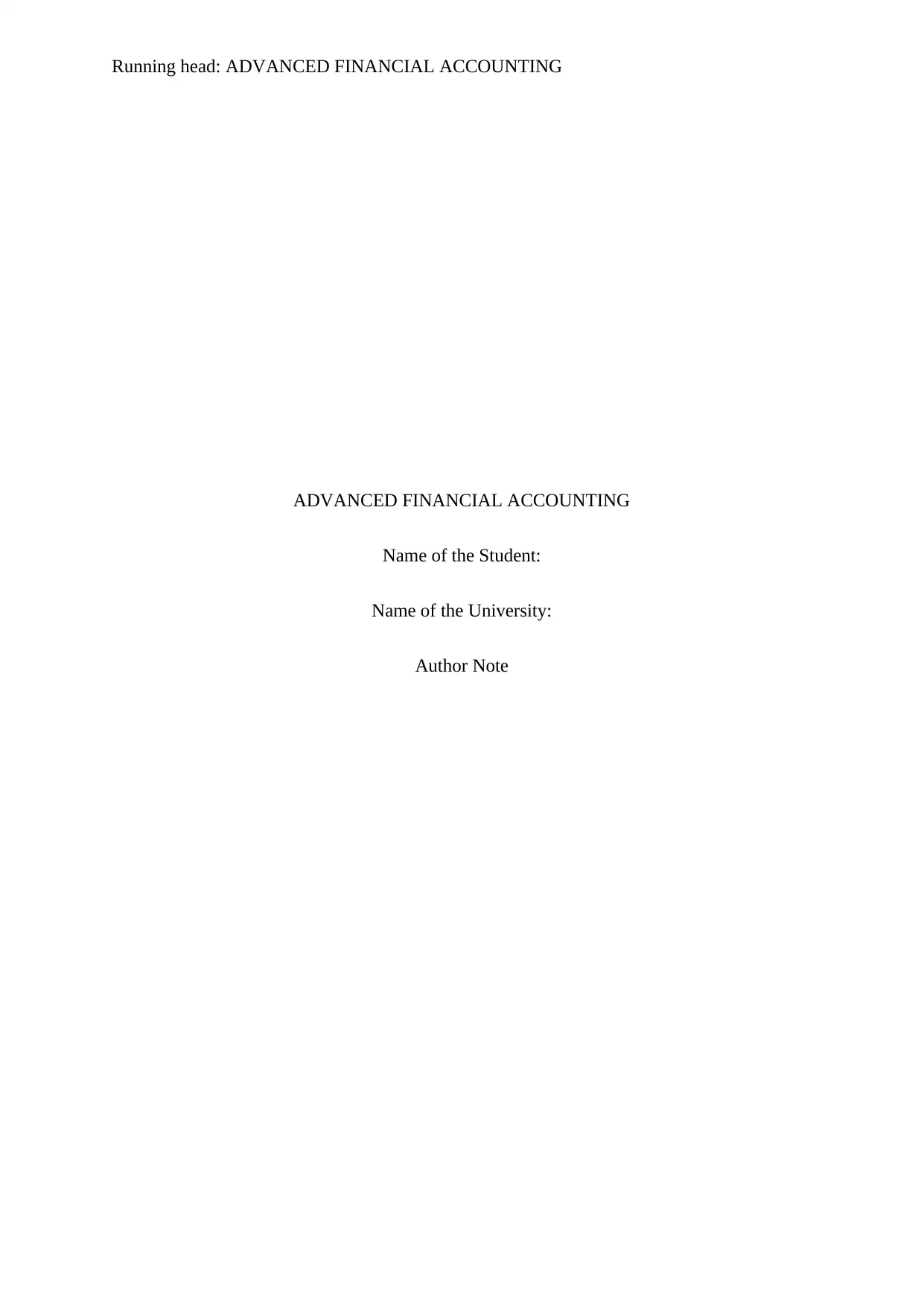
Running head: ADVANCED FINANCIAL ACCOUNTING
ADVANCED FINANCIAL ACCOUNTING
Name of the Student:
Name of the University:
Author Note
ADVANCED FINANCIAL ACCOUNTING
Name of the Student:
Name of the University:
Author Note
Paraphrase This Document
Need a fresh take? Get an instant paraphrase of this document with our AI Paraphraser

1ADVANCED FINANCIAL ACCOUNTING
Table of Contents
Introduction................................................................................................................................2
Discussion..................................................................................................................................2
Accounting concept................................................................................................................2
Entity concept.....................................................................................................................3
Dual Aspect Concept..........................................................................................................3
Going Business Concept....................................................................................................3
Money Measurement concept............................................................................................3
Cost Concept......................................................................................................................4
Cost attach concept............................................................................................................4
Accounting Period Concept...............................................................................................4
Accrual Concept.................................................................................................................4
Realization Concept...........................................................................................................5
Verifiable objective evidence concept...............................................................................5
Conceptual Framework..........................................................................................................5
Accounting measurement.......................................................................................................5
Issues in Accounting Measurement.......................................................................................6
Australian Accounting Regulatory Framework and the Conceptual Framework..................8
Australian standards for Assets..............................................................................................8
Accounting for leases.............................................................................................................9
Conclusion..................................................................................................................................9
References................................................................................................................................11
Table of Contents
Introduction................................................................................................................................2
Discussion..................................................................................................................................2
Accounting concept................................................................................................................2
Entity concept.....................................................................................................................3
Dual Aspect Concept..........................................................................................................3
Going Business Concept....................................................................................................3
Money Measurement concept............................................................................................3
Cost Concept......................................................................................................................4
Cost attach concept............................................................................................................4
Accounting Period Concept...............................................................................................4
Accrual Concept.................................................................................................................4
Realization Concept...........................................................................................................5
Verifiable objective evidence concept...............................................................................5
Conceptual Framework..........................................................................................................5
Accounting measurement.......................................................................................................5
Issues in Accounting Measurement.......................................................................................6
Australian Accounting Regulatory Framework and the Conceptual Framework..................8
Australian standards for Assets..............................................................................................8
Accounting for leases.............................................................................................................9
Conclusion..................................................................................................................................9
References................................................................................................................................11
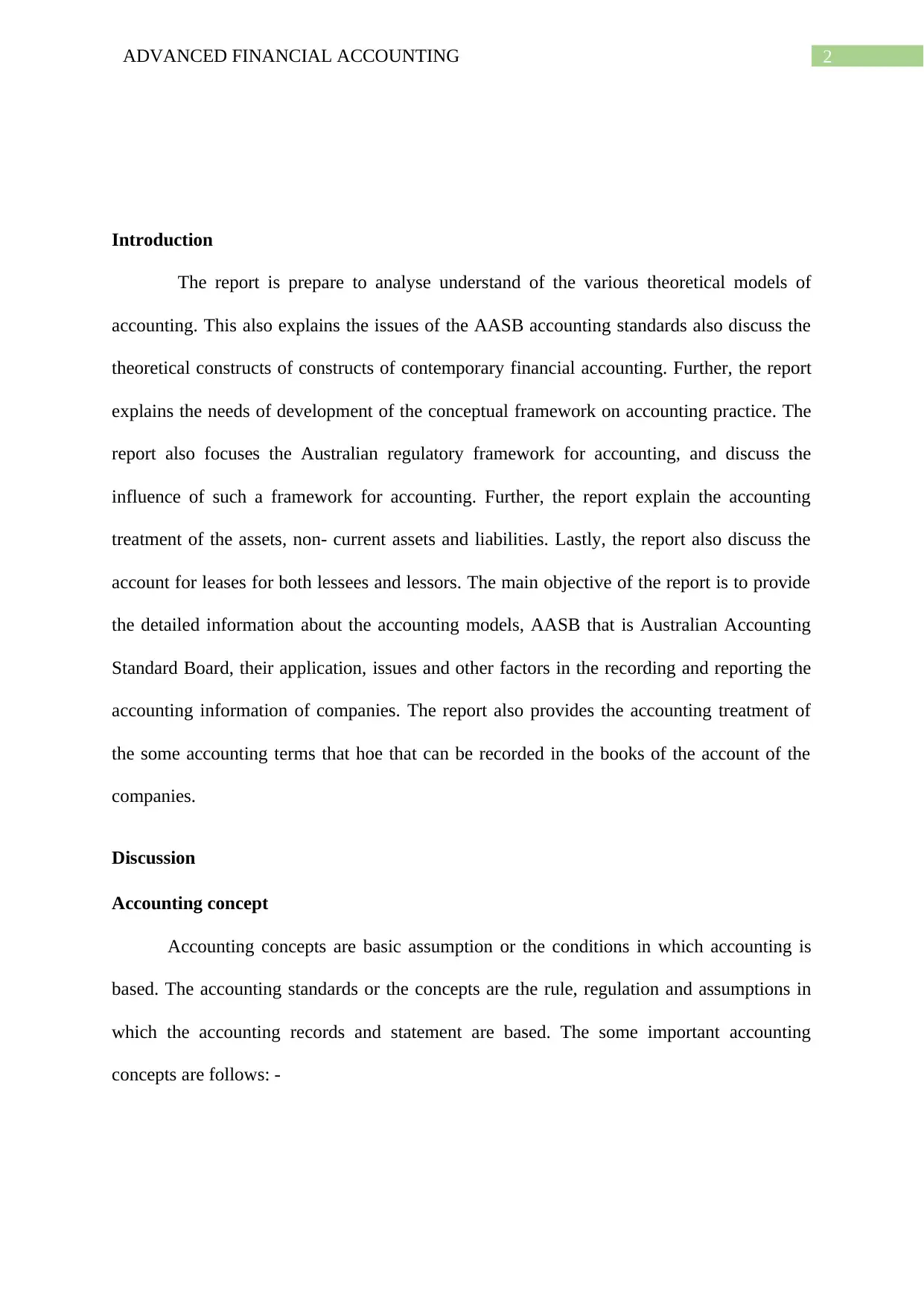
2ADVANCED FINANCIAL ACCOUNTING
Introduction
The report is prepare to analyse understand of the various theoretical models of
accounting. This also explains the issues of the AASB accounting standards also discuss the
theoretical constructs of constructs of contemporary financial accounting. Further, the report
explains the needs of development of the conceptual framework on accounting practice. The
report also focuses the Australian regulatory framework for accounting, and discuss the
influence of such a framework for accounting. Further, the report explain the accounting
treatment of the assets, non- current assets and liabilities. Lastly, the report also discuss the
account for leases for both lessees and lessors. The main objective of the report is to provide
the detailed information about the accounting models, AASB that is Australian Accounting
Standard Board, their application, issues and other factors in the recording and reporting the
accounting information of companies. The report also provides the accounting treatment of
the some accounting terms that hoe that can be recorded in the books of the account of the
companies.
Discussion
Accounting concept
Accounting concepts are basic assumption or the conditions in which accounting is
based. The accounting standards or the concepts are the rule, regulation and assumptions in
which the accounting records and statement are based. The some important accounting
concepts are follows: -
Introduction
The report is prepare to analyse understand of the various theoretical models of
accounting. This also explains the issues of the AASB accounting standards also discuss the
theoretical constructs of constructs of contemporary financial accounting. Further, the report
explains the needs of development of the conceptual framework on accounting practice. The
report also focuses the Australian regulatory framework for accounting, and discuss the
influence of such a framework for accounting. Further, the report explain the accounting
treatment of the assets, non- current assets and liabilities. Lastly, the report also discuss the
account for leases for both lessees and lessors. The main objective of the report is to provide
the detailed information about the accounting models, AASB that is Australian Accounting
Standard Board, their application, issues and other factors in the recording and reporting the
accounting information of companies. The report also provides the accounting treatment of
the some accounting terms that hoe that can be recorded in the books of the account of the
companies.
Discussion
Accounting concept
Accounting concepts are basic assumption or the conditions in which accounting is
based. The accounting standards or the concepts are the rule, regulation and assumptions in
which the accounting records and statement are based. The some important accounting
concepts are follows: -
⊘ This is a preview!⊘
Do you want full access?
Subscribe today to unlock all pages.

Trusted by 1+ million students worldwide
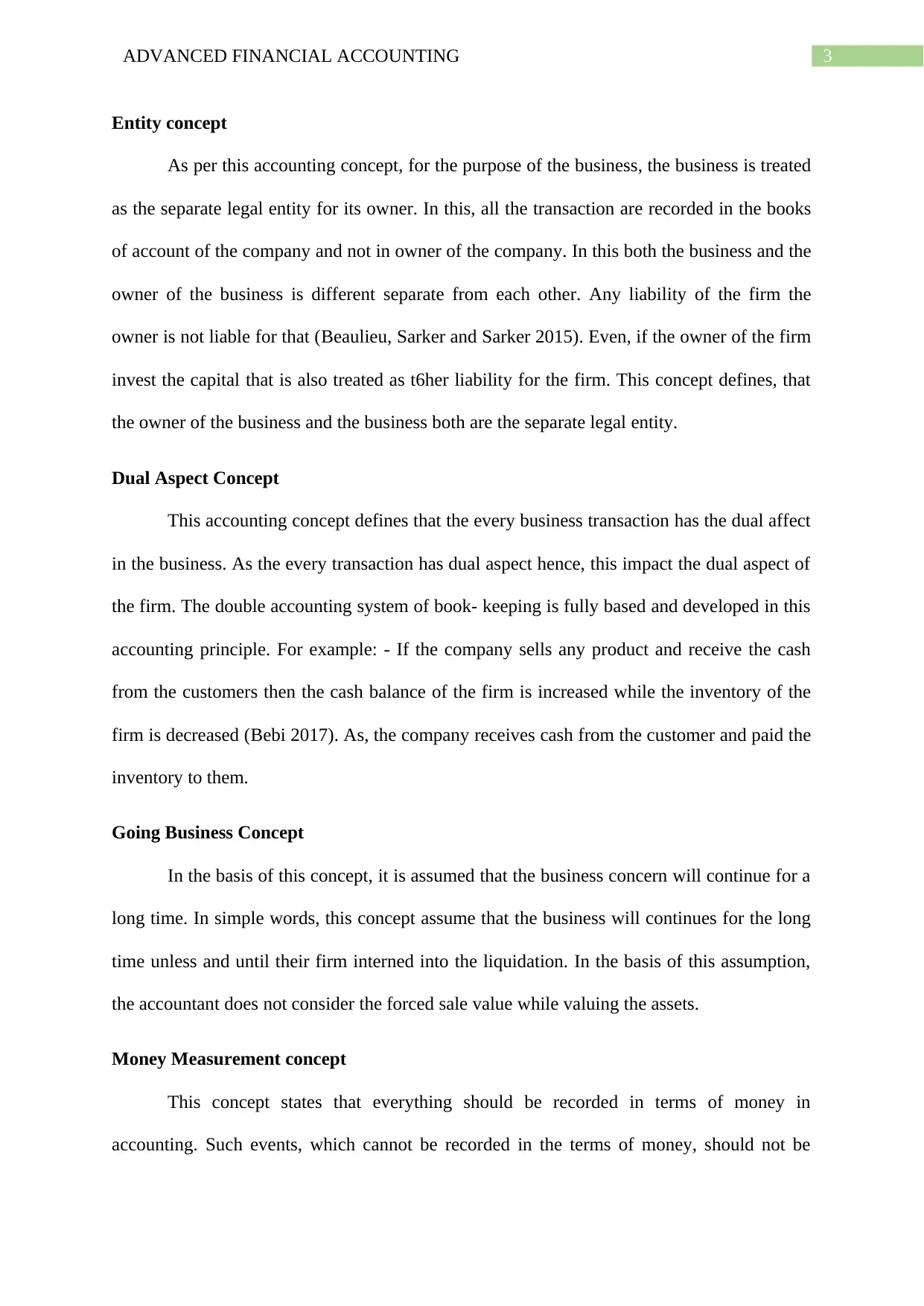
3ADVANCED FINANCIAL ACCOUNTING
Entity concept
As per this accounting concept, for the purpose of the business, the business is treated
as the separate legal entity for its owner. In this, all the transaction are recorded in the books
of account of the company and not in owner of the company. In this both the business and the
owner of the business is different separate from each other. Any liability of the firm the
owner is not liable for that (Beaulieu, Sarker and Sarker 2015). Even, if the owner of the firm
invest the capital that is also treated as t6her liability for the firm. This concept defines, that
the owner of the business and the business both are the separate legal entity.
Dual Aspect Concept
This accounting concept defines that the every business transaction has the dual affect
in the business. As the every transaction has dual aspect hence, this impact the dual aspect of
the firm. The double accounting system of book- keeping is fully based and developed in this
accounting principle. For example: - If the company sells any product and receive the cash
from the customers then the cash balance of the firm is increased while the inventory of the
firm is decreased (Bebi 2017). As, the company receives cash from the customer and paid the
inventory to them.
Going Business Concept
In the basis of this concept, it is assumed that the business concern will continue for a
long time. In simple words, this concept assume that the business will continues for the long
time unless and until their firm interned into the liquidation. In the basis of this assumption,
the accountant does not consider the forced sale value while valuing the assets.
Money Measurement concept
This concept states that everything should be recorded in terms of money in
accounting. Such events, which cannot be recorded in the terms of money, should not be
Entity concept
As per this accounting concept, for the purpose of the business, the business is treated
as the separate legal entity for its owner. In this, all the transaction are recorded in the books
of account of the company and not in owner of the company. In this both the business and the
owner of the business is different separate from each other. Any liability of the firm the
owner is not liable for that (Beaulieu, Sarker and Sarker 2015). Even, if the owner of the firm
invest the capital that is also treated as t6her liability for the firm. This concept defines, that
the owner of the business and the business both are the separate legal entity.
Dual Aspect Concept
This accounting concept defines that the every business transaction has the dual affect
in the business. As the every transaction has dual aspect hence, this impact the dual aspect of
the firm. The double accounting system of book- keeping is fully based and developed in this
accounting principle. For example: - If the company sells any product and receive the cash
from the customers then the cash balance of the firm is increased while the inventory of the
firm is decreased (Bebi 2017). As, the company receives cash from the customer and paid the
inventory to them.
Going Business Concept
In the basis of this concept, it is assumed that the business concern will continue for a
long time. In simple words, this concept assume that the business will continues for the long
time unless and until their firm interned into the liquidation. In the basis of this assumption,
the accountant does not consider the forced sale value while valuing the assets.
Money Measurement concept
This concept states that everything should be recorded in terms of money in
accounting. Such events, which cannot be recorded in the terms of money, should not be
Paraphrase This Document
Need a fresh take? Get an instant paraphrase of this document with our AI Paraphraser
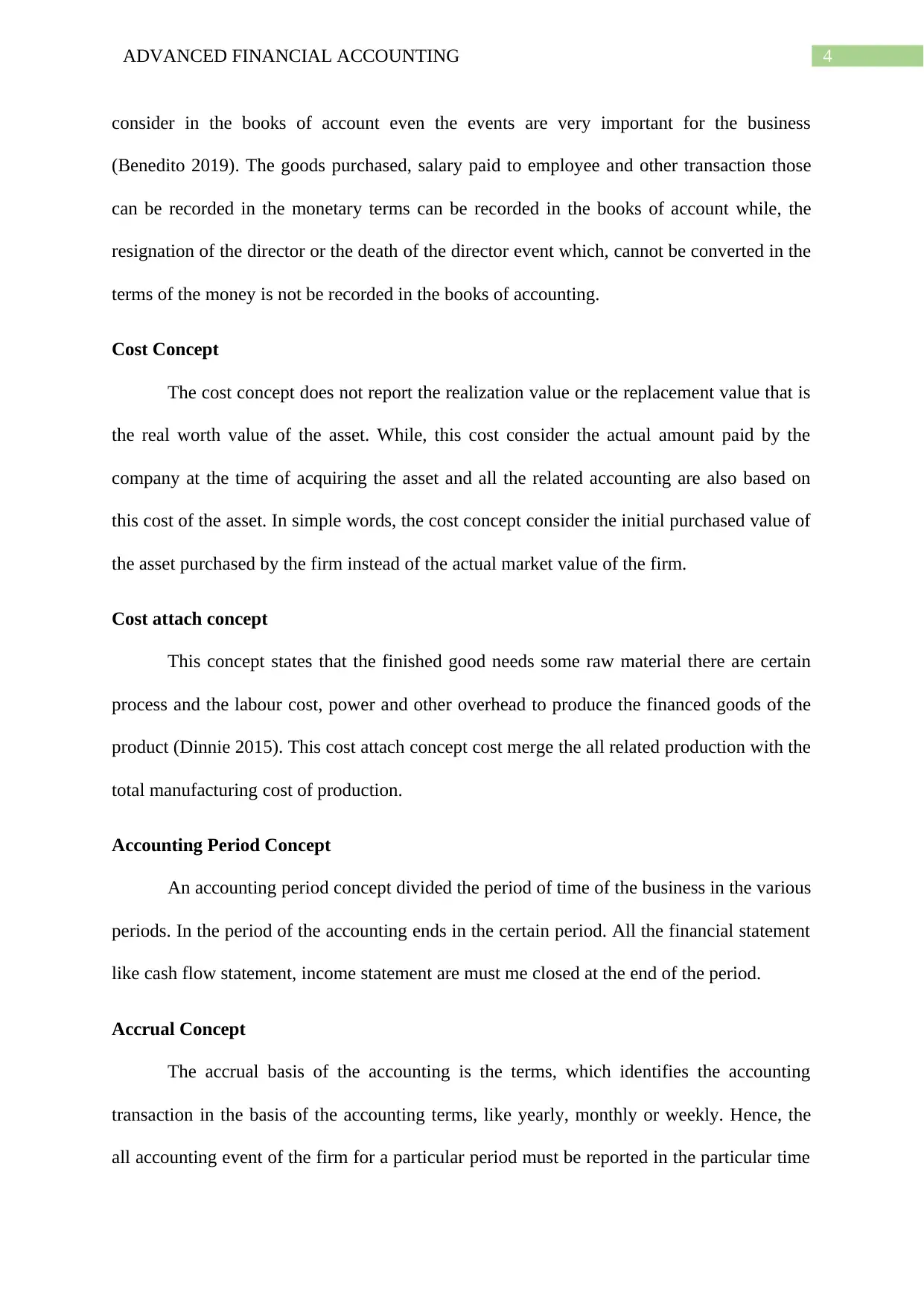
4ADVANCED FINANCIAL ACCOUNTING
consider in the books of account even the events are very important for the business
(Benedito 2019). The goods purchased, salary paid to employee and other transaction those
can be recorded in the monetary terms can be recorded in the books of account while, the
resignation of the director or the death of the director event which, cannot be converted in the
terms of the money is not be recorded in the books of accounting.
Cost Concept
The cost concept does not report the realization value or the replacement value that is
the real worth value of the asset. While, this cost consider the actual amount paid by the
company at the time of acquiring the asset and all the related accounting are also based on
this cost of the asset. In simple words, the cost concept consider the initial purchased value of
the asset purchased by the firm instead of the actual market value of the firm.
Cost attach concept
This concept states that the finished good needs some raw material there are certain
process and the labour cost, power and other overhead to produce the financed goods of the
product (Dinnie 2015). This cost attach concept cost merge the all related production with the
total manufacturing cost of production.
Accounting Period Concept
An accounting period concept divided the period of time of the business in the various
periods. In the period of the accounting ends in the certain period. All the financial statement
like cash flow statement, income statement are must me closed at the end of the period.
Accrual Concept
The accrual basis of the accounting is the terms, which identifies the accounting
transaction in the basis of the accounting terms, like yearly, monthly or weekly. Hence, the
all accounting event of the firm for a particular period must be reported in the particular time
consider in the books of account even the events are very important for the business
(Benedito 2019). The goods purchased, salary paid to employee and other transaction those
can be recorded in the monetary terms can be recorded in the books of account while, the
resignation of the director or the death of the director event which, cannot be converted in the
terms of the money is not be recorded in the books of accounting.
Cost Concept
The cost concept does not report the realization value or the replacement value that is
the real worth value of the asset. While, this cost consider the actual amount paid by the
company at the time of acquiring the asset and all the related accounting are also based on
this cost of the asset. In simple words, the cost concept consider the initial purchased value of
the asset purchased by the firm instead of the actual market value of the firm.
Cost attach concept
This concept states that the finished good needs some raw material there are certain
process and the labour cost, power and other overhead to produce the financed goods of the
product (Dinnie 2015). This cost attach concept cost merge the all related production with the
total manufacturing cost of production.
Accounting Period Concept
An accounting period concept divided the period of time of the business in the various
periods. In the period of the accounting ends in the certain period. All the financial statement
like cash flow statement, income statement are must me closed at the end of the period.
Accrual Concept
The accrual basis of the accounting is the terms, which identifies the accounting
transaction in the basis of the accounting terms, like yearly, monthly or weekly. Hence, the
all accounting event of the firm for a particular period must be reported in the particular time
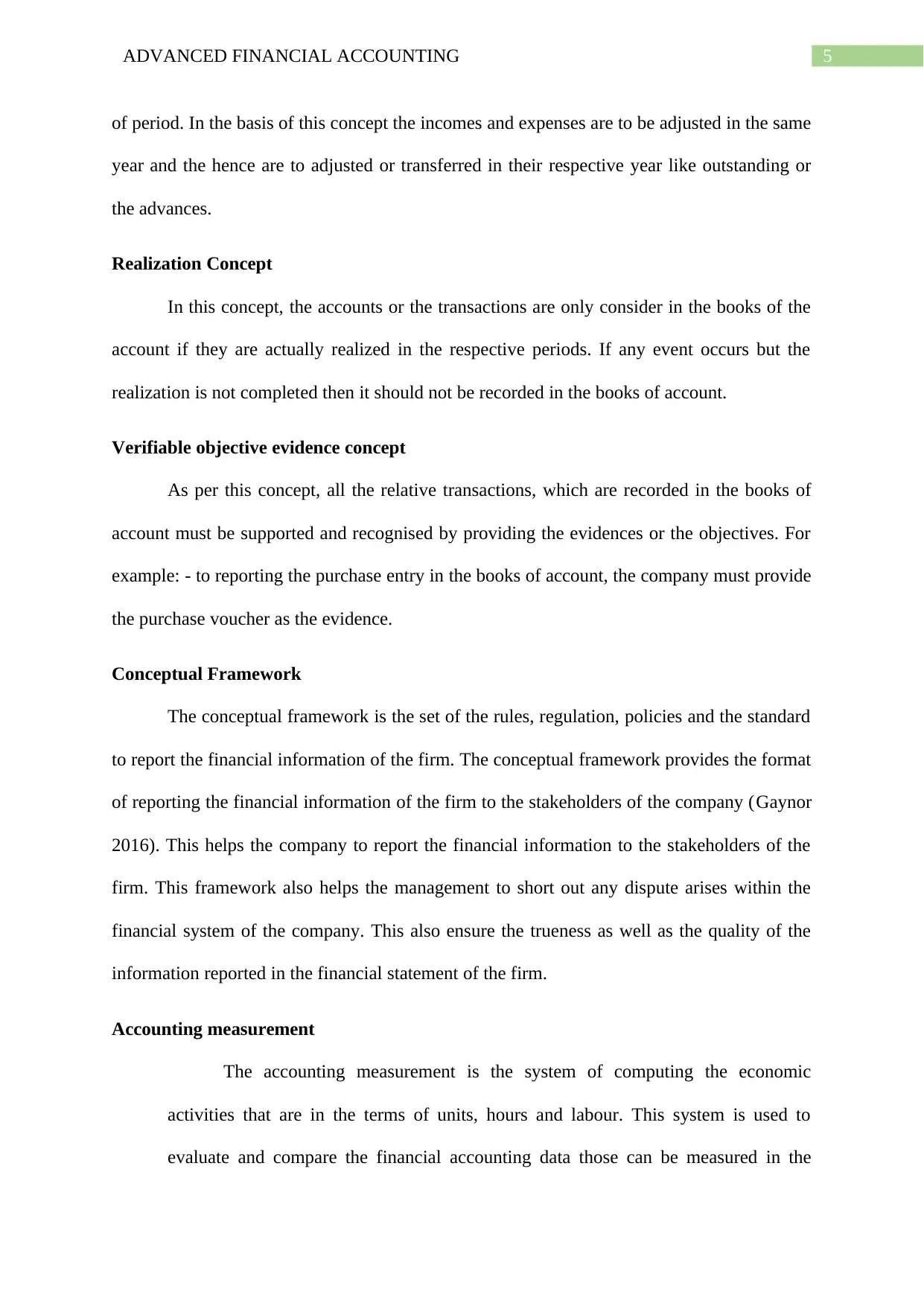
5ADVANCED FINANCIAL ACCOUNTING
of period. In the basis of this concept the incomes and expenses are to be adjusted in the same
year and the hence are to adjusted or transferred in their respective year like outstanding or
the advances.
Realization Concept
In this concept, the accounts or the transactions are only consider in the books of the
account if they are actually realized in the respective periods. If any event occurs but the
realization is not completed then it should not be recorded in the books of account.
Verifiable objective evidence concept
As per this concept, all the relative transactions, which are recorded in the books of
account must be supported and recognised by providing the evidences or the objectives. For
example: - to reporting the purchase entry in the books of account, the company must provide
the purchase voucher as the evidence.
Conceptual Framework
The conceptual framework is the set of the rules, regulation, policies and the standard
to report the financial information of the firm. The conceptual framework provides the format
of reporting the financial information of the firm to the stakeholders of the company (Gaynor
2016). This helps the company to report the financial information to the stakeholders of the
firm. This framework also helps the management to short out any dispute arises within the
financial system of the company. This also ensure the trueness as well as the quality of the
information reported in the financial statement of the firm.
Accounting measurement
The accounting measurement is the system of computing the economic
activities that are in the terms of units, hours and labour. This system is used to
evaluate and compare the financial accounting data those can be measured in the
of period. In the basis of this concept the incomes and expenses are to be adjusted in the same
year and the hence are to adjusted or transferred in their respective year like outstanding or
the advances.
Realization Concept
In this concept, the accounts or the transactions are only consider in the books of the
account if they are actually realized in the respective periods. If any event occurs but the
realization is not completed then it should not be recorded in the books of account.
Verifiable objective evidence concept
As per this concept, all the relative transactions, which are recorded in the books of
account must be supported and recognised by providing the evidences or the objectives. For
example: - to reporting the purchase entry in the books of account, the company must provide
the purchase voucher as the evidence.
Conceptual Framework
The conceptual framework is the set of the rules, regulation, policies and the standard
to report the financial information of the firm. The conceptual framework provides the format
of reporting the financial information of the firm to the stakeholders of the company (Gaynor
2016). This helps the company to report the financial information to the stakeholders of the
firm. This framework also helps the management to short out any dispute arises within the
financial system of the company. This also ensure the trueness as well as the quality of the
information reported in the financial statement of the firm.
Accounting measurement
The accounting measurement is the system of computing the economic
activities that are in the terms of units, hours and labour. This system is used to
evaluate and compare the financial accounting data those can be measured in the
⊘ This is a preview!⊘
Do you want full access?
Subscribe today to unlock all pages.

Trusted by 1+ million students worldwide
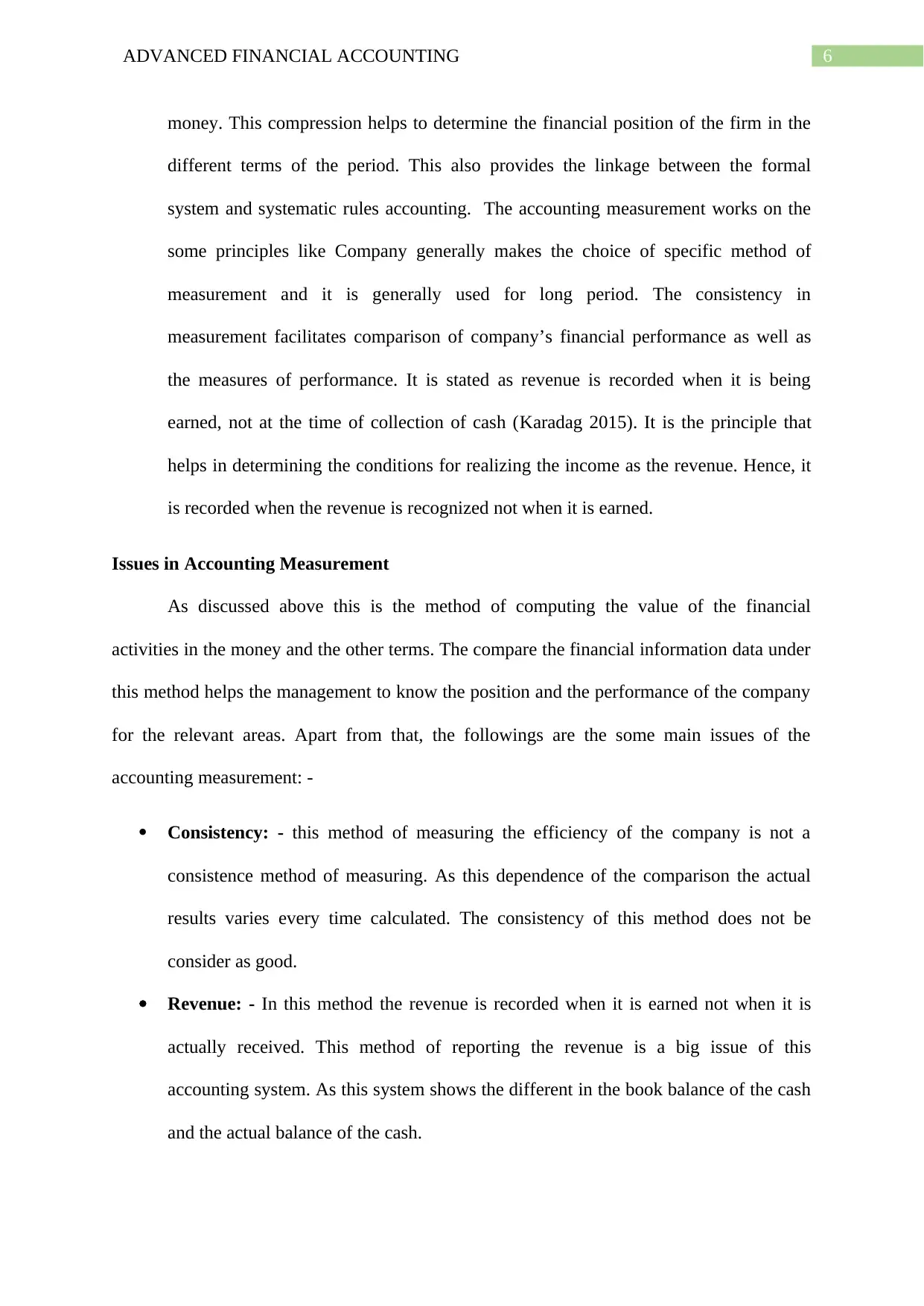
6ADVANCED FINANCIAL ACCOUNTING
money. This compression helps to determine the financial position of the firm in the
different terms of the period. This also provides the linkage between the formal
system and systematic rules accounting. The accounting measurement works on the
some principles like Company generally makes the choice of specific method of
measurement and it is generally used for long period. The consistency in
measurement facilitates comparison of company’s financial performance as well as
the measures of performance. It is stated as revenue is recorded when it is being
earned, not at the time of collection of cash (Karadag 2015). It is the principle that
helps in determining the conditions for realizing the income as the revenue. Hence, it
is recorded when the revenue is recognized not when it is earned.
Issues in Accounting Measurement
As discussed above this is the method of computing the value of the financial
activities in the money and the other terms. The compare the financial information data under
this method helps the management to know the position and the performance of the company
for the relevant areas. Apart from that, the followings are the some main issues of the
accounting measurement: -
Consistency: - this method of measuring the efficiency of the company is not a
consistence method of measuring. As this dependence of the comparison the actual
results varies every time calculated. The consistency of this method does not be
consider as good.
Revenue: - In this method the revenue is recorded when it is earned not when it is
actually received. This method of reporting the revenue is a big issue of this
accounting system. As this system shows the different in the book balance of the cash
and the actual balance of the cash.
money. This compression helps to determine the financial position of the firm in the
different terms of the period. This also provides the linkage between the formal
system and systematic rules accounting. The accounting measurement works on the
some principles like Company generally makes the choice of specific method of
measurement and it is generally used for long period. The consistency in
measurement facilitates comparison of company’s financial performance as well as
the measures of performance. It is stated as revenue is recorded when it is being
earned, not at the time of collection of cash (Karadag 2015). It is the principle that
helps in determining the conditions for realizing the income as the revenue. Hence, it
is recorded when the revenue is recognized not when it is earned.
Issues in Accounting Measurement
As discussed above this is the method of computing the value of the financial
activities in the money and the other terms. The compare the financial information data under
this method helps the management to know the position and the performance of the company
for the relevant areas. Apart from that, the followings are the some main issues of the
accounting measurement: -
Consistency: - this method of measuring the efficiency of the company is not a
consistence method of measuring. As this dependence of the comparison the actual
results varies every time calculated. The consistency of this method does not be
consider as good.
Revenue: - In this method the revenue is recorded when it is earned not when it is
actually received. This method of reporting the revenue is a big issue of this
accounting system. As this system shows the different in the book balance of the cash
and the actual balance of the cash.
Paraphrase This Document
Need a fresh take? Get an instant paraphrase of this document with our AI Paraphraser
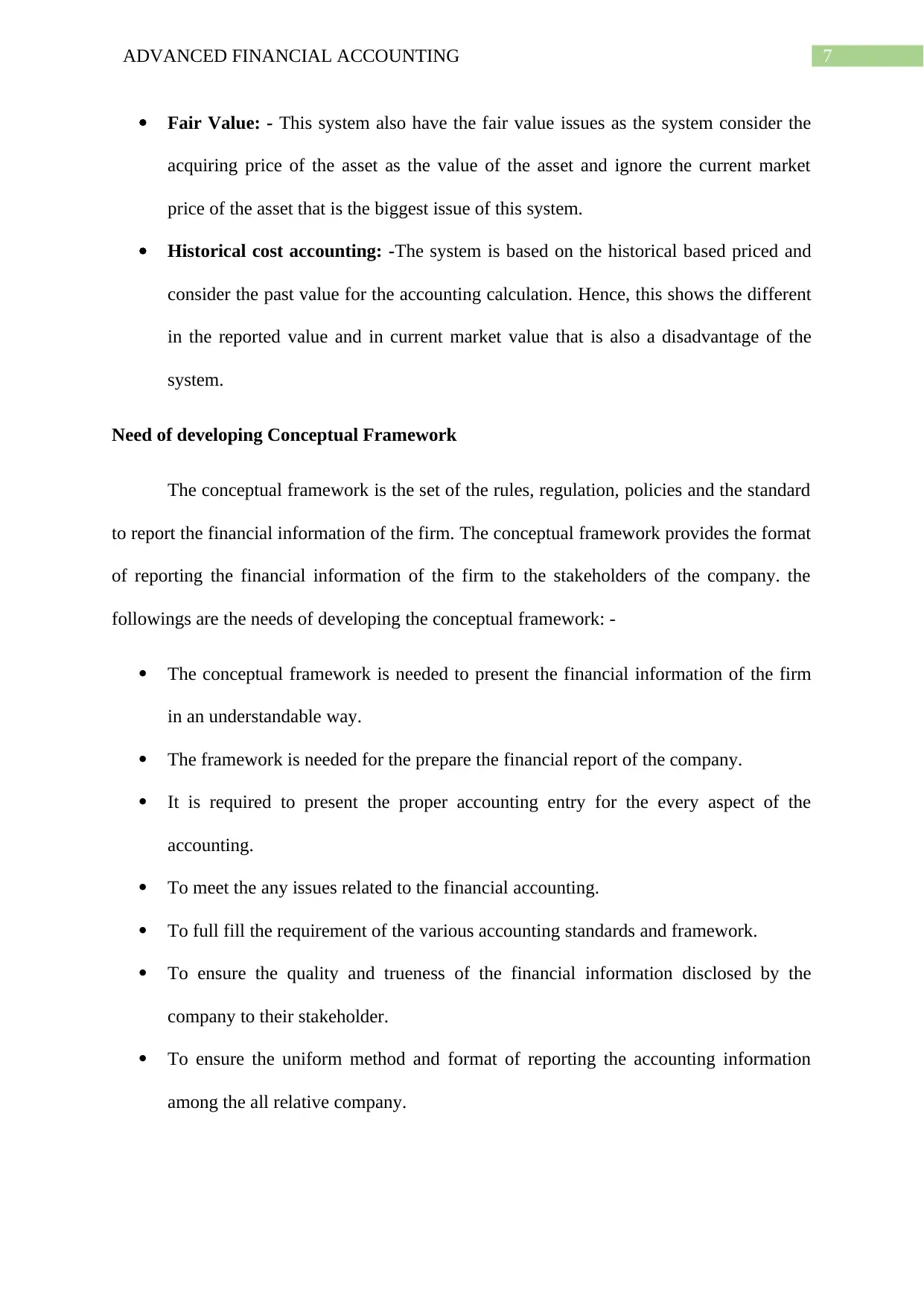
7ADVANCED FINANCIAL ACCOUNTING
Fair Value: - This system also have the fair value issues as the system consider the
acquiring price of the asset as the value of the asset and ignore the current market
price of the asset that is the biggest issue of this system.
Historical cost accounting: -The system is based on the historical based priced and
consider the past value for the accounting calculation. Hence, this shows the different
in the reported value and in current market value that is also a disadvantage of the
system.
Need of developing Conceptual Framework
The conceptual framework is the set of the rules, regulation, policies and the standard
to report the financial information of the firm. The conceptual framework provides the format
of reporting the financial information of the firm to the stakeholders of the company. the
followings are the needs of developing the conceptual framework: -
The conceptual framework is needed to present the financial information of the firm
in an understandable way.
The framework is needed for the prepare the financial report of the company.
It is required to present the proper accounting entry for the every aspect of the
accounting.
To meet the any issues related to the financial accounting.
To full fill the requirement of the various accounting standards and framework.
To ensure the quality and trueness of the financial information disclosed by the
company to their stakeholder.
To ensure the uniform method and format of reporting the accounting information
among the all relative company.
Fair Value: - This system also have the fair value issues as the system consider the
acquiring price of the asset as the value of the asset and ignore the current market
price of the asset that is the biggest issue of this system.
Historical cost accounting: -The system is based on the historical based priced and
consider the past value for the accounting calculation. Hence, this shows the different
in the reported value and in current market value that is also a disadvantage of the
system.
Need of developing Conceptual Framework
The conceptual framework is the set of the rules, regulation, policies and the standard
to report the financial information of the firm. The conceptual framework provides the format
of reporting the financial information of the firm to the stakeholders of the company. the
followings are the needs of developing the conceptual framework: -
The conceptual framework is needed to present the financial information of the firm
in an understandable way.
The framework is needed for the prepare the financial report of the company.
It is required to present the proper accounting entry for the every aspect of the
accounting.
To meet the any issues related to the financial accounting.
To full fill the requirement of the various accounting standards and framework.
To ensure the quality and trueness of the financial information disclosed by the
company to their stakeholder.
To ensure the uniform method and format of reporting the accounting information
among the all relative company.
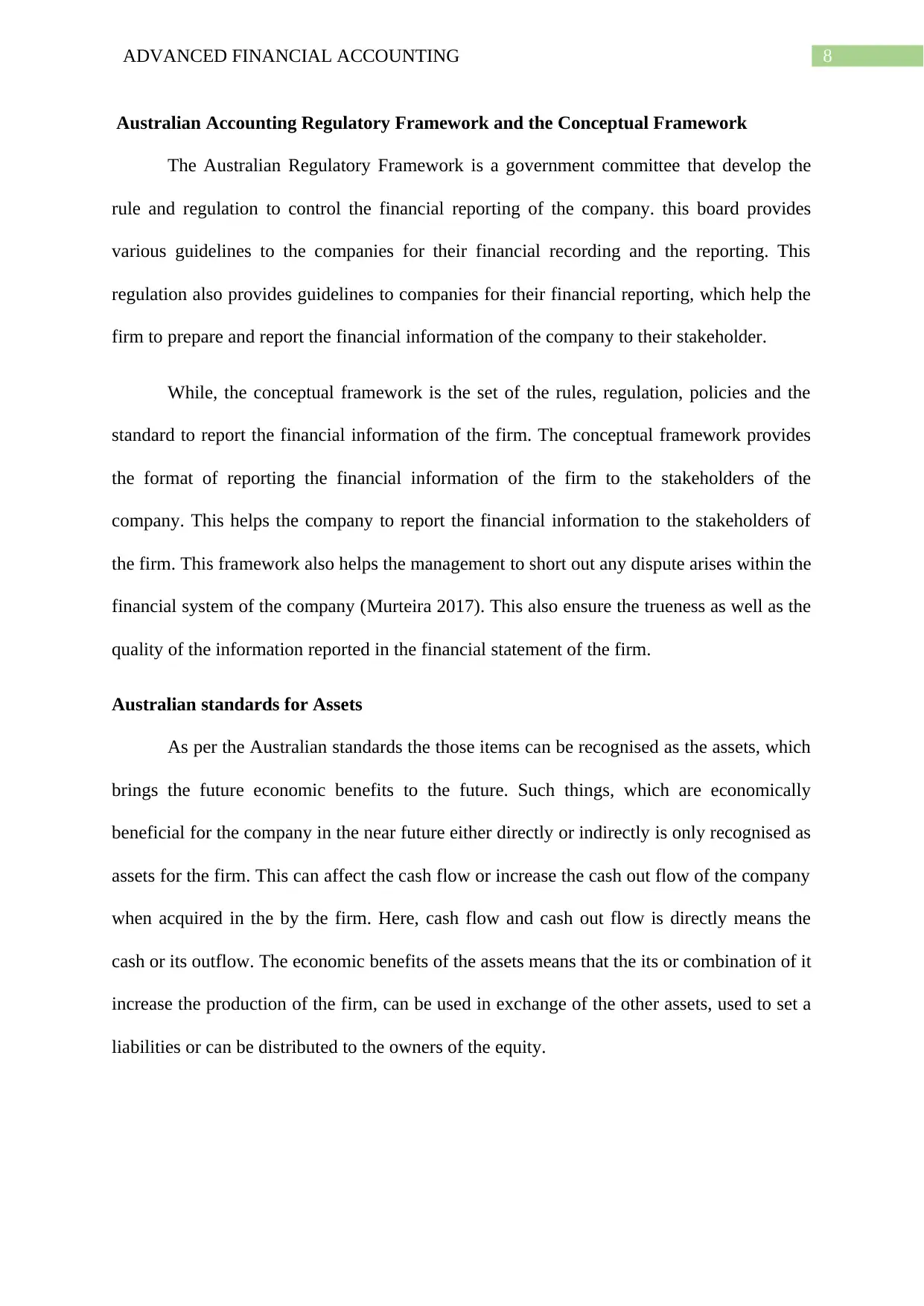
8ADVANCED FINANCIAL ACCOUNTING
Australian Accounting Regulatory Framework and the Conceptual Framework
The Australian Regulatory Framework is a government committee that develop the
rule and regulation to control the financial reporting of the company. this board provides
various guidelines to the companies for their financial recording and the reporting. This
regulation also provides guidelines to companies for their financial reporting, which help the
firm to prepare and report the financial information of the company to their stakeholder.
While, the conceptual framework is the set of the rules, regulation, policies and the
standard to report the financial information of the firm. The conceptual framework provides
the format of reporting the financial information of the firm to the stakeholders of the
company. This helps the company to report the financial information to the stakeholders of
the firm. This framework also helps the management to short out any dispute arises within the
financial system of the company (Murteira 2017). This also ensure the trueness as well as the
quality of the information reported in the financial statement of the firm.
Australian standards for Assets
As per the Australian standards the those items can be recognised as the assets, which
brings the future economic benefits to the future. Such things, which are economically
beneficial for the company in the near future either directly or indirectly is only recognised as
assets for the firm. This can affect the cash flow or increase the cash out flow of the company
when acquired in the by the firm. Here, cash flow and cash out flow is directly means the
cash or its outflow. The economic benefits of the assets means that the its or combination of it
increase the production of the firm, can be used in exchange of the other assets, used to set a
liabilities or can be distributed to the owners of the equity.
Australian Accounting Regulatory Framework and the Conceptual Framework
The Australian Regulatory Framework is a government committee that develop the
rule and regulation to control the financial reporting of the company. this board provides
various guidelines to the companies for their financial recording and the reporting. This
regulation also provides guidelines to companies for their financial reporting, which help the
firm to prepare and report the financial information of the company to their stakeholder.
While, the conceptual framework is the set of the rules, regulation, policies and the
standard to report the financial information of the firm. The conceptual framework provides
the format of reporting the financial information of the firm to the stakeholders of the
company. This helps the company to report the financial information to the stakeholders of
the firm. This framework also helps the management to short out any dispute arises within the
financial system of the company (Murteira 2017). This also ensure the trueness as well as the
quality of the information reported in the financial statement of the firm.
Australian standards for Assets
As per the Australian standards the those items can be recognised as the assets, which
brings the future economic benefits to the future. Such things, which are economically
beneficial for the company in the near future either directly or indirectly is only recognised as
assets for the firm. This can affect the cash flow or increase the cash out flow of the company
when acquired in the by the firm. Here, cash flow and cash out flow is directly means the
cash or its outflow. The economic benefits of the assets means that the its or combination of it
increase the production of the firm, can be used in exchange of the other assets, used to set a
liabilities or can be distributed to the owners of the equity.
⊘ This is a preview!⊘
Do you want full access?
Subscribe today to unlock all pages.

Trusted by 1+ million students worldwide
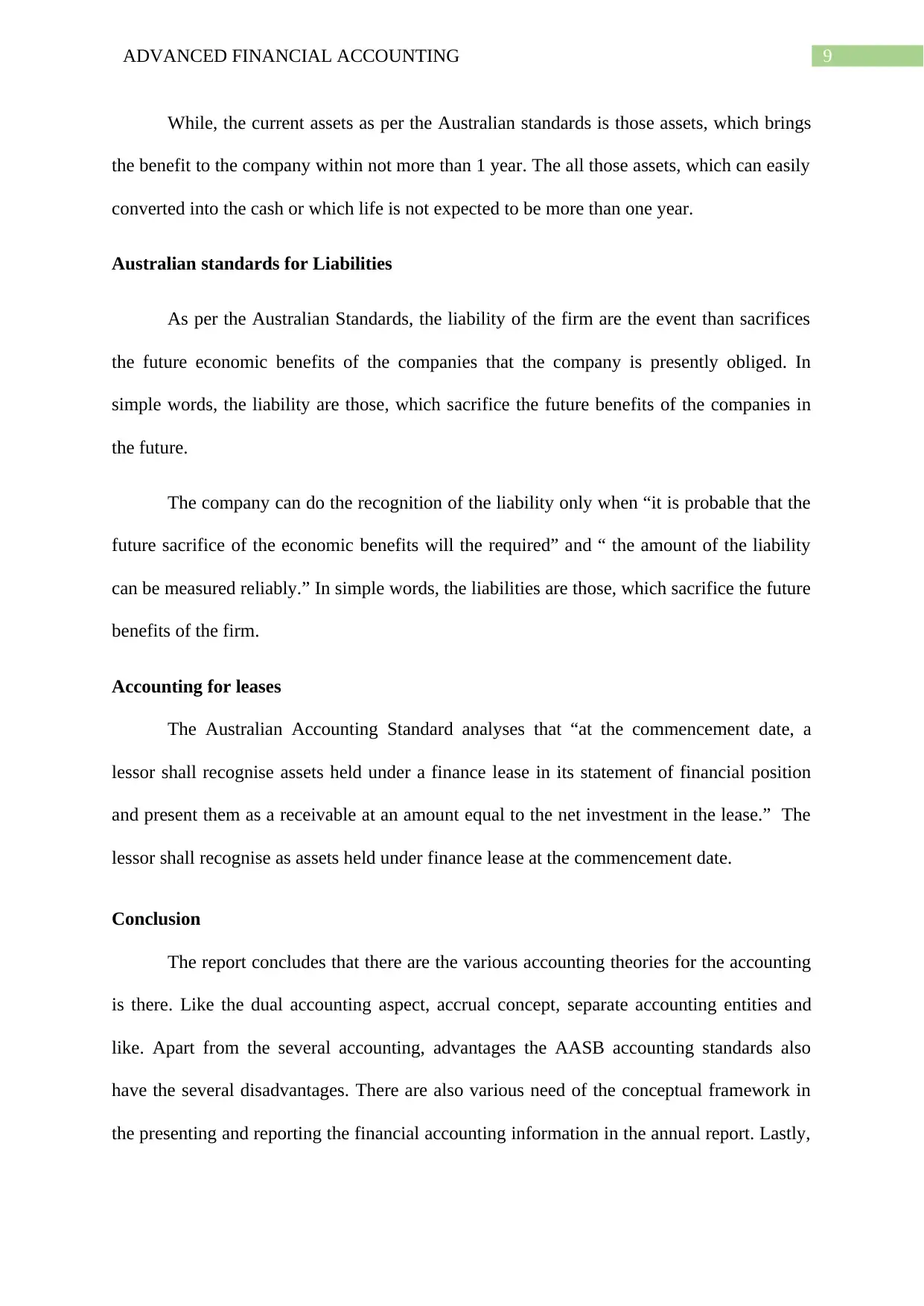
9ADVANCED FINANCIAL ACCOUNTING
While, the current assets as per the Australian standards is those assets, which brings
the benefit to the company within not more than 1 year. The all those assets, which can easily
converted into the cash or which life is not expected to be more than one year.
Australian standards for Liabilities
As per the Australian Standards, the liability of the firm are the event than sacrifices
the future economic benefits of the companies that the company is presently obliged. In
simple words, the liability are those, which sacrifice the future benefits of the companies in
the future.
The company can do the recognition of the liability only when “it is probable that the
future sacrifice of the economic benefits will the required” and “ the amount of the liability
can be measured reliably.” In simple words, the liabilities are those, which sacrifice the future
benefits of the firm.
Accounting for leases
The Australian Accounting Standard analyses that “at the commencement date, a
lessor shall recognise assets held under a finance lease in its statement of financial position
and present them as a receivable at an amount equal to the net investment in the lease.” The
lessor shall recognise as assets held under finance lease at the commencement date.
Conclusion
The report concludes that there are the various accounting theories for the accounting
is there. Like the dual accounting aspect, accrual concept, separate accounting entities and
like. Apart from the several accounting, advantages the AASB accounting standards also
have the several disadvantages. There are also various need of the conceptual framework in
the presenting and reporting the financial accounting information in the annual report. Lastly,
While, the current assets as per the Australian standards is those assets, which brings
the benefit to the company within not more than 1 year. The all those assets, which can easily
converted into the cash or which life is not expected to be more than one year.
Australian standards for Liabilities
As per the Australian Standards, the liability of the firm are the event than sacrifices
the future economic benefits of the companies that the company is presently obliged. In
simple words, the liability are those, which sacrifice the future benefits of the companies in
the future.
The company can do the recognition of the liability only when “it is probable that the
future sacrifice of the economic benefits will the required” and “ the amount of the liability
can be measured reliably.” In simple words, the liabilities are those, which sacrifice the future
benefits of the firm.
Accounting for leases
The Australian Accounting Standard analyses that “at the commencement date, a
lessor shall recognise assets held under a finance lease in its statement of financial position
and present them as a receivable at an amount equal to the net investment in the lease.” The
lessor shall recognise as assets held under finance lease at the commencement date.
Conclusion
The report concludes that there are the various accounting theories for the accounting
is there. Like the dual accounting aspect, accrual concept, separate accounting entities and
like. Apart from the several accounting, advantages the AASB accounting standards also
have the several disadvantages. There are also various need of the conceptual framework in
the presenting and reporting the financial accounting information in the annual report. Lastly,
Paraphrase This Document
Need a fresh take? Get an instant paraphrase of this document with our AI Paraphraser

10ADVANCED FINANCIAL ACCOUNTING
the Australian accounting regulatory provides the various framework for the assets, liabilities
and the leases.
the Australian accounting regulatory provides the various framework for the assets, liabilities
and the leases.
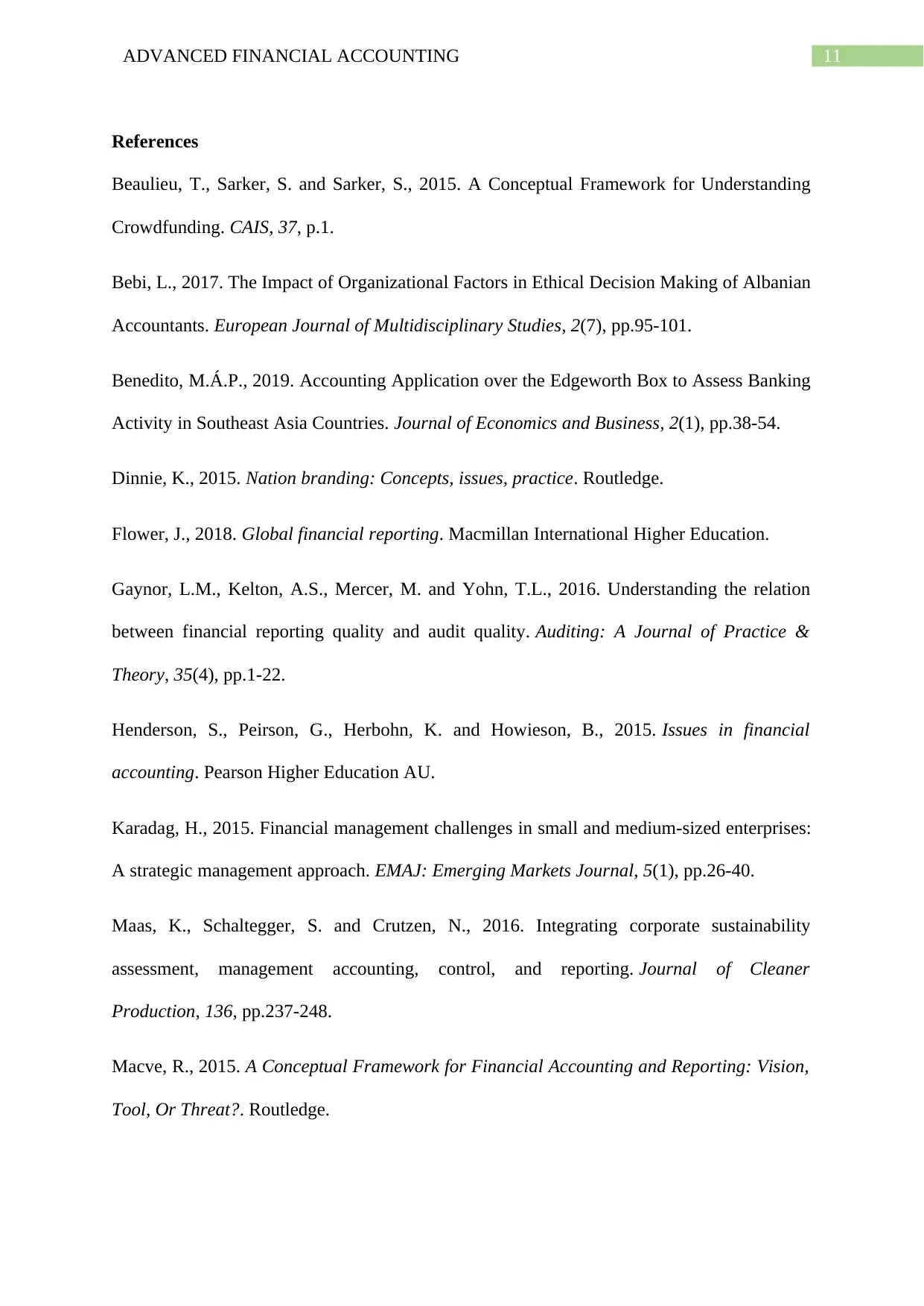
11ADVANCED FINANCIAL ACCOUNTING
References
Beaulieu, T., Sarker, S. and Sarker, S., 2015. A Conceptual Framework for Understanding
Crowdfunding. CAIS, 37, p.1.
Bebi, L., 2017. The Impact of Organizational Factors in Ethical Decision Making of Albanian
Accountants. European Journal of Multidisciplinary Studies, 2(7), pp.95-101.
Benedito, M.Á.P., 2019. Accounting Application over the Edgeworth Box to Assess Banking
Activity in Southeast Asia Countries. Journal of Economics and Business, 2(1), pp.38-54.
Dinnie, K., 2015. Nation branding: Concepts, issues, practice. Routledge.
Flower, J., 2018. Global financial reporting. Macmillan International Higher Education.
Gaynor, L.M., Kelton, A.S., Mercer, M. and Yohn, T.L., 2016. Understanding the relation
between financial reporting quality and audit quality. Auditing: A Journal of Practice &
Theory, 35(4), pp.1-22.
Henderson, S., Peirson, G., Herbohn, K. and Howieson, B., 2015. Issues in financial
accounting. Pearson Higher Education AU.
Karadag, H., 2015. Financial management challenges in small and medium-sized enterprises:
A strategic management approach. EMAJ: Emerging Markets Journal, 5(1), pp.26-40.
Maas, K., Schaltegger, S. and Crutzen, N., 2016. Integrating corporate sustainability
assessment, management accounting, control, and reporting. Journal of Cleaner
Production, 136, pp.237-248.
Macve, R., 2015. A Conceptual Framework for Financial Accounting and Reporting: Vision,
Tool, Or Threat?. Routledge.
References
Beaulieu, T., Sarker, S. and Sarker, S., 2015. A Conceptual Framework for Understanding
Crowdfunding. CAIS, 37, p.1.
Bebi, L., 2017. The Impact of Organizational Factors in Ethical Decision Making of Albanian
Accountants. European Journal of Multidisciplinary Studies, 2(7), pp.95-101.
Benedito, M.Á.P., 2019. Accounting Application over the Edgeworth Box to Assess Banking
Activity in Southeast Asia Countries. Journal of Economics and Business, 2(1), pp.38-54.
Dinnie, K., 2015. Nation branding: Concepts, issues, practice. Routledge.
Flower, J., 2018. Global financial reporting. Macmillan International Higher Education.
Gaynor, L.M., Kelton, A.S., Mercer, M. and Yohn, T.L., 2016. Understanding the relation
between financial reporting quality and audit quality. Auditing: A Journal of Practice &
Theory, 35(4), pp.1-22.
Henderson, S., Peirson, G., Herbohn, K. and Howieson, B., 2015. Issues in financial
accounting. Pearson Higher Education AU.
Karadag, H., 2015. Financial management challenges in small and medium-sized enterprises:
A strategic management approach. EMAJ: Emerging Markets Journal, 5(1), pp.26-40.
Maas, K., Schaltegger, S. and Crutzen, N., 2016. Integrating corporate sustainability
assessment, management accounting, control, and reporting. Journal of Cleaner
Production, 136, pp.237-248.
Macve, R., 2015. A Conceptual Framework for Financial Accounting and Reporting: Vision,
Tool, Or Threat?. Routledge.
⊘ This is a preview!⊘
Do you want full access?
Subscribe today to unlock all pages.

Trusted by 1+ million students worldwide
1 out of 13
Related Documents
Your All-in-One AI-Powered Toolkit for Academic Success.
+13062052269
info@desklib.com
Available 24*7 on WhatsApp / Email
![[object Object]](/_next/static/media/star-bottom.7253800d.svg)
Unlock your academic potential
Copyright © 2020–2025 A2Z Services. All Rights Reserved. Developed and managed by ZUCOL.





